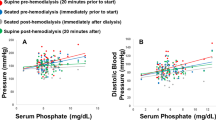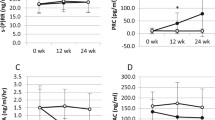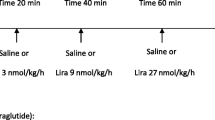Abstract
Unexplained hypertension was observed in three anephric children on hemodialysis. We investigated the possible involvement of a novel hypertensive extra-renal enzyme new pressor protein (NPP), related to coagulation β-FXIIa. Currently, NPP activity can only be determined by a rat bioassay model. On study day 1, pre dialysis, patients 1, 2, and 3 were hypertensive and their plasmas raised rat systolic blood pressure (SBP) by 45, 34, and 9 mmHg, respectively. Post dialysis, patients 1 and 2 reached their estimated dry body weight and their systemic pressures dropped, while patient 3 remained hypertensive and hypervolemic. Their post-dialysis plasmas raised rat SBP by 22, 14, and 9 mmHg, respectively. On day 2, similar relationships between patient SBP, volume status, and plasma NPP-like activity in rats were observed. The characteristic rat BP responses, lack of inhibition by captopril (ruling out a renin-mediated effect), and inhibition by soybean trypsin inhibitor support co-identity with NPP. Plasma FXIIa (combined α-FXIIa and β-FXIIa) was measured by immunoassay and found to be elevated in all patients. This investigation suggests that there is high endogenous NPP activity in the plasmas of these hypertensive hemodialysis patients, it changes with SBP and fluid volume, and is a possible contributor to their hypertension. Further studies are required to examine the wider applicability of these novel findings.




Similar content being viewed by others
References
Mendley SR, Fine R, Tejani A (2001) Dialysis in infants and children. In: Daugirdas JT, Blake PG, Ing TS (eds) Handbook of dialysis, 3rd edn. Lippincott Williams & Wilkins, Philadelphia, pp 562–579
Horl MP, Horl WH (2002) Hemodialysis-associated hypertension: pathophysiology and therapy. Am J Kidney Dis 39:227–244
Converse RLJ, Jacobsen TN, Toto RD, Jost CM, Consentino F, Fouad-Tarazi F, Victor RG (1992) Sympathetic overactivity in patients with chronic renal failure. N Engl J Med 327:1912–1918
Komatsu Y, Ito K (1992) Erythropoietin associated hypertension among pediatric dialysis patients. Adv Perit Dial 8:448–452
Seguias L, Zilleruelo G, Strauss J, Abitbol C, Montane B (2001) Angiotensin-II and endothelin-1 levels in children with renoprival hypertension. Pediatr Nephrol 16:493–496
Osmond DH, Mavrogiannis L, Cotter BR (1998) Potent ‘new pressor protein’ related to coagulation factor XII is potentiated by inhibition of angiotensin converting enzyme inhibition (ACEI). J Hypertens 16:311–320
Mavrogiannis L, Kariyawasam KPAP, Osmond DH (1997) Potent blood pressure raising effects of activated coagulation factor XII. Can J Physiol Pharmacol 75:1398–1403
Mavrogiannis L, Trambakoulos D, Boomsma F, Osmond DH (2002) The sympathoadrenal system mediates the blood pressure and cardiac effects of human coagulation FXII-related “new pressor protein”. Can J Cardiol 18:1077–1086
Simos D, Boomsma F, Osmond DH (2002) Human coagulation FXII-related ‘new pressor protein’: role of PACAP in its cardiovascular and sympathoadrenal effects. Can J Cardiol 18:1093–1103
Coppola R, Cristilli P, Cugno M, Ariens RA, Mari D, Mannucci PM (1996) Measurement of activated factor XII in health and disease. Blood Coagul Fibrinolysis 7:530–535
Salmon J, Cardigan R, Mackie I, Cohen SL, Machin S, Singer M (1997) Continuous venovenous hemofiltration using polyacrylonitrile filters does not activate contact system and intrinsic coagulation pathways. Intensive Care Med 23:38–43
Matsuo T, Koide M, Kario K, Suzuki S, Matsuo M (1997) Extrinsic coagulation factors and tissue factor pathway inhibitor in end-stage chronic renal failure. Haemostasis 27:163–167
Svensson M, Friberger P, Lundstrom O, Stegmayr B (1996) Activation of FXII during haemodialysis. Scand J Clin Lab Invest 56:649–652
Frank RD, Weber J, Dresbach H, Thelen H, Weiss C, Floege J (2001) Role of contact system activation in hemodialyzer-induced thrombogenicity. Kidney Int 60:1972–1981
Colhoun HM, Zito F, Norman Chan N, Rubens MB, Fuller JH, Humphries SE (2002) Activated factor XII levels and factor XII 46C>T genotype in relation to coronary artery calcification in patients with type 1 diabetes and healthy subjects. Atherosclerosis 163:363–369
Nevard CHF, Jurd KM, Lane D, Philippou H, Haycock GB, Hunt BJ (1997). Activation of coagulation and fibrinolysis in childhood diarrhoea-associated haemolytic uraemic syndrome. Thromb Haemost 78:1450–1455
Hoorn FA van der, Boomsma F, Man in ‘t Veld AJ, Schalekamp MA (1989). Determination of catecholamines in human plasma by high-performance liquid chromatography: comparison between a new method with fluorescence detection and an established method with electrochemical detection. J Chromatogr 487:17–28
Renaux JL, Thomas M, Crost T, Loughraieb N, Vantard G (1999) Activation of the kallikrein-kinin system in hemodialysis: role of membrane electronegativity, blood dilution and pH. Kidney Int 55:1097–1103
Rich JB (1998) The efficacy and safety of aprotinin use in cardiac surgery. Ann Thor Surg 66 [Suppl 5]:S6–S11
Asimakopoulos G (2001) Systemic inflammation and cardiac surgery: an update. Perfusion 16:353–360
Jaquiss RD, Ghanayem NS, Zacharisen MC, Mussatto KA, Tweddell JS, Litwin SB (2002) Safety of aprotinin use and re-use in pediatric cardiothoracic surgery. Circulation 106 [Suppl 1]:I90–194
Tweddell JS, Hoffman GM, Mussatto KA, Fedderly RT, Berger S, Jaquiss RD, Ghanayem NS, Frisbee SJ, Litwin SB (2002) Improved survival of patients undergoing palliation of hypoplastic left heart syndrome: lessons learned from 115 consecutive patients. Circulation 106 [Suppl 1]:182–189
Acknowledgements
These results were presented at the American Society of Nephrology 35th Annual Meeting and Scientific Exposition, 1–4 November 2002, Philadelphia, Pa., USA, and at the American Science Meeting, 14–17 May 2003, New York, NY, USA. This study was supported by the Heart and Stroke Foundation of Ontario (HSFO) grants NA 3478 and T4136. Peter C. Papageorgiou is a recipient of an AHEPA CANADA and HCFO scholarship.
Author information
Authors and Affiliations
Corresponding author
Additional information
An erratum to this article can be found at http://dx.doi.org/10.1007/s00467-003-1359-y
R.J. Pearl and P.C. Papageorgiou contributed equally to this work
Rights and permissions
About this article
Cite this article
Pearl, R.J., Papageorgiou, P.C., Goldman, M. et al. Possible role of new pressor protein in hypertensive anephric hemodialysis patients. Pediatr Nephrol 18, 1025–1031 (2003). https://doi.org/10.1007/s00467-003-1246-6
Received:
Revised:
Accepted:
Published:
Issue Date:
DOI: https://doi.org/10.1007/s00467-003-1246-6




